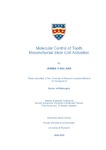Molecular Control of Tooth Mesenchymal Stem Cell Activation
| dc.contributor.supervisor | Hu, Bing | |
| dc.contributor.author | Walker, Jemma Victoria | |
| dc.contributor.other | Faculty of Health | en_US |
| dc.date.accessioned | 2019-07-03T14:01:34Z | |
| dc.date.issued | 2019 | |
| dc.identifier | 10494181 | en_US |
| dc.identifier.uri | http://hdl.handle.net/10026.1/14585 | |
| dc.description.abstract |
Background The continuously growing mouse incisor provides a robust model for studying molecular mechanisms of stem cell (SC) fate determination. While the epithelial SCs are well studied within this model, the identification and characterisation of a mesenchymal SC (MSC) population has yet to be defined. Aims This study aims to identify the molecular signatures of a novel MSC pool within the lower murine incisor. This work aims to investigate the molecular mechanisms governing the maintenance and transition of MSC cells and their progeny, particularly the role of Notch signalling in this process. Methods Isolation of proposed putative MSC containing and known mesenchymal transit amplifying cell (MTAC) containing regions were undertaken. Laser capture microdissection and subsequent comparative analysis of MSC marker expression between populations was performed. Investigation of the molecular mechanisms governing MSC activation and maintenance was undertaken. Specifically, the role of Notch signalling was investigated, through analysis of Notch pathway transgenic mouse models including tissue specific RBP-Jκ knock out, Dlk1 null, and tissue specific Dlk1 overexpressing strains. In vitro models were developed to validate findings. Results MTAC and MSC containing regions exhibited distinct expression signatures of quiescent MSC marker genes. Notch pathway ligands, receptors and downstream effectors were differentially expressed between these populations. Modulation of Notch signalling in vivo impacted the behaviour of incisor MSCs. Manipulation of Dlk1 in vitro identified it as a potent regulator of MTAC maintenance. Conclusions The novel endogenous MSC population exists within the mouse incisor mesenchyme. The MSCs give rise to cells of the MTAC region, which in turn express Notch ligand Dlk1. Dlk1 is pivotal in balancing the lineage differentiation and maintenance of the incisor MSCs. Thus, Notch signalling plays a key role in the molecular regulation of the activation of tooth mesenchymal stem cells. | en_US |
| dc.language.iso | en | |
| dc.publisher | University of Plymouth | |
| dc.rights | Attribution-NonCommercial 3.0 United States | * |
| dc.rights.uri | http://creativecommons.org/licenses/by-nc/3.0/us/ | * |
| dc.subject | Stem Cell | en_US |
| dc.subject | Mesenchyme | en_US |
| dc.subject | Dental | en_US |
| dc.subject | Notch | en_US |
| dc.subject | Incisor | en_US |
| dc.subject.classification | PhD | en_US |
| dc.title | Molecular Control of Tooth Mesenchymal Stem Cell Activation | en_US |
| dc.type | Thesis | |
| plymouth.version | publishable | en_US |
| dc.identifier.doi | http://dx.doi.org/10.24382/1040 | |
| dc.rights.embargodate | 2020-07-03T14:01:34Z | |
| dc.rights.embargoperiod | 12 months | en_US |
| dc.type.qualification | Doctorate | en_US |
| rioxxterms.version | NA | |
| plymouth.orcid_id | https://orcid.org/0000-0003-1349-2633 | en_US |
Files in this item
This item appears in the following Collection(s)
-
01 Research Theses Main Collection
Research Theses Main



